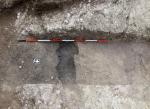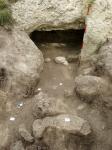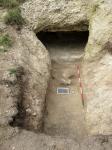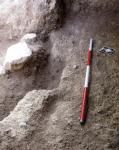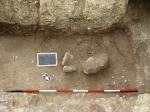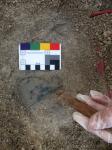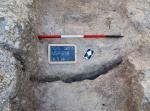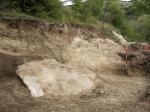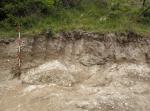Summary (English)
Trench 1, Locality of Giardino a Caldo
This season, excavations in trench 1 did not continue the work that concluded in 2015 above the phase 1 levels. The complex dates to between the 4th and 6th century A.D. Surface survey undertaken on the slopes south of trench 1 revealed the presence of terracing systems (walls of irregular blocks of local limestone), probably connected with agricultural activities. The structures were photographed and geo-referenced. Numerous fragments of proto-historic impasto pottery (_dolia_) were collected during the survey, including a rim datable to the 8th century B.C.
Locality of Lama Soriano
Excavation continued in the corridor leading into the ‘a grotticella’ tomb (grotticella 2), only partially investigated in 2015. The excavations halted in correspondence with the southern edge of the terrace (southern entrance to the dromos), altered by modern interventions. The corridor, 2.90 m long and 0.85 m wide, was aligned north-south and sloped slightly to the south. It was entirely cut into the calcareous breccias, to a maximum depth of 0.90 m. The floor of the burial chamber was higher than that of the dromos, and presented a niche in correspondence with the entrance, probably created to aid the drainage of the bodily fluids. Two flat surfaced calcareous stones placed in the dromos next to the niche may have formed the threshold. Both the entrance to the funerary chamber (north entrance), and the corridor’s southern entrance had moulded jambs. The latter was sealed by a rectangular hearth and an accumulation of stones positioned at the end of the last burial. The occupation layers in the corridor contained numerous skeletal remains (adult and infant), faunal remains, pottery fragments, a number of iron objects – including several nails, a fragmentary fibula and a strigil that was ritually broken and bent – and an intact bronze razor. The materials were mainly concentrated in the central part of the corridor and in front of the burial chamber’s entrance, lying among calcareous stones. The complete removal of the deposit inside the dromos revealed the presence of a cut in the bedrock perpendicular to the corridor’s axis (0.85 m long, max. width 0.10 m, depth 0.25 cm), that probably served as the housing for a closing slab, later removed and not reused. During the investigations, the calcareous slope west of grotticella 2 was cleaned exposing an area c. 20 m long and 2 m high. Traces of a substantial landslide were documented, whose impact altered the zone’s morphology (accumulation of sediments and detritus, some of notable size) and obliterated an inhumation burial in a simple rock-cut grave. Partially articulated skeletal remains, that had presumably sipped down from the slope, were recorded and recovered south of the cut, at a depth of c. 1.50 m below present ground level.
- Alessandro Felici - Matrix 96 Società Cooperativa
- Francesca Romana Del Fattore – Sabap-Aq
Director
- Antonio Curci - Dipartimento di Storia Culture Civiltà – Università degli Studi di Bologna “Alma Mater Studiorum”
Team
- Anna Rizzo - Dipartimento di Storia Culture Civiltà – Università degli Studi di Bologna “Alma Mater Studiorum”
- Lionello Morandi – University of Reading – Department of Archaeology, School of Human and Environmental Sciences
- Melania Gigante – Sezione di Bioarcheologia Museo Preistorico ed Etnografico "Luigi Pigorini"
- Veronica Villa – Accademia di Belle Arti di Bologna
- Andrea Schiappelli – Sovrintendenza di Roma Capitale
- Barbara Ottani - Università di Bologna
- Chiara Tebaldi - Dipartimento di Storia Culture Civiltà – Università degli Studi di Bologna “Alma Mater Studiorum”
- Gianfranco de Rossi
- Enrica Gori - Dipartimento di Storia Culture Civiltà – Università degli Studi di Bologna “Alma Mater Studiorum”
Research Body
- Centro di Ricerche di Bioarcheologia – ArcheoLaBio, Dipartimento di Storia Culture Civiltà, Università degli Studi di Bologna “Alma Mater Studiorum”
- Sezione di Bioarcheologia Museo Preistorico ed Etnografico "Luigi Pigorini"
Funding Body
- Comune di Scanno
- Matrix 96 Società Cooperativa
- Rotary Club Roma Ovest





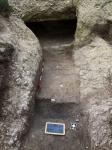
![Download [PDF]](/excavation/skins/fasti/images/results/download_sml.png)
